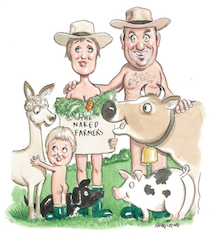Pyromaniac that I am, I love the burning off season. Lines of fire, snaking across country and into the bush, lighting up the late winter nights with their warming glow. I love to light them, putting a lit match to the bladey grass and hearing it snap, crackle and roar. As a general rule, we don’t burn Avalon, because we believe in repeatedly slashing the grass and mulching the land to retain moisture and build up the soil levels to create healthier soil and pasture. 5 years ago when we came here, the land was all bladey grass, bracken fern and fireweed, now we have beautiful native grasses, kikuyu, clover and oatey grass, and the bladey grass is almost gone. Burning bladey grass might give you green pick for the cattle, but all you get is more bladey grass, so it never made much sense to us. However, as a way of seeing what is there in areas that have not been slashed, it is invaluable, and as a way of quickly clearing the land without slashing, it can be useful. But not our preferred way of doing things.
Anyway, the Friday before Ostara, the spring equinox and the real Easter in the southern hemisphere, it was a dull day, with moisture in the air, no beating sun and the hint of rain to come, so Ben and I thought we would just quickly light some fires to burn down into the weeds along a section of the river bank and into the neighbour’s paddock, which she has always invited us to burn. We lit a few fires along the fence line which blazed up briefly and then fizzled so we figured they would be out momentarily and went home for lunch. About 4 hours later we drove over to feed the horses and I saw the wall of smoke . . . ‘I think we have a problem’ I said to Ben. He wasn’t concerned. He’s heard Mummy say that before when she’s inadvertently burnt a paddock!
We drove over the ridge and saw a line of flames licking voraciously at everything in its path. 500 metres from the site of our start up fires and travelling in the opposite direction to our intention! We weren’t going to even try to beat this one back, it was going to have to keep gorging until it was replete. All we could do, was damage limitation. We drove down to the horses and set them free. Then we splashed water all around the water tank above base camp and removed all the water pipes, stand pipe and hoses. Then back burnt around the tank just to make sure. Next we drove through Henry Hollow and up into the Dam Paddock and there we stopped in shock and horror. We were faced with a blackened wasteland and facing us were the bee hives standing sentry like and stark white against the ash. ‘The bees! Daddy is going to go mental’ One hive was already swarming. One was still smouldering. All our lovely workers, all the new frames and comb all ready to be filled with lovely, life giving honey. All my fault . . .
We rang Ged and told him the bad news. But it was to get worse. By the time he came home two hives were burnt to cinders and we will have to start again with nucleus hives. He found a hive of European bees in a fallen tree and bear like tried to extract the comb and honey and then persuade some to take up residence in some of our boxes but they didn’t want to relocate despite their hot home, so that didn’t work out the way we planned it either. The fire continued on its merry way all night and for two days thereafter, clearing, cleaning, exposing.
At least we are rid of the high load of dead grass before the predicted drought gains intensity – although the ground is already so dry, the river lower than it was at the end of the last drought, we are desperately begging for rain. And the fire has cleaned up and rid us of old stumps and piles we inherited from the previous owners. And the exciting news is that what we really wanted to burn, the oasis with the spring in the middle, is now accessible and we can see the tree graveyard in there. This is obviously where they used to go to extract millable timber, cut fence posts and strainers etc. I spent two days in there, black from head to foot, lugging logs and branches and chainsawing wood to make it manouvrable, feeding the existing fires to clear areas of all the fallen timber. There’s another 6 months work in there but it will be beautiful when it is done. A lush green forest, a shady oasis in the middle of the pasture where the stock can retreat to on hot days and Ben and I can wander in awe.
We have to take the long view in farming. And I am learning that stressing achieves nothing. There was no point in trying to fight that fire, she obviously wanted to be burnt. And now she is.
Working in the blackened aftermath over the weekend, I meditated on the cleansing fire, the phoenix arising, and the rebirth and renewal offered both by the fire and the first days of spring. How it was possible to rebuild and restart in the ashes – relationships, friendships, dreams, plans, futures. Here is the cycle of life in all its stark reality – death, decay, rebirth. Every aspect of our lives affected by these never ending circles and rhythms if we could only realise it, and stop demanding the excitement and blossoming of eternal spring. We have to learn to live with the circles and cycles, see them, accept them and even embrace them as essential for our evolving, revolving life on earth.

